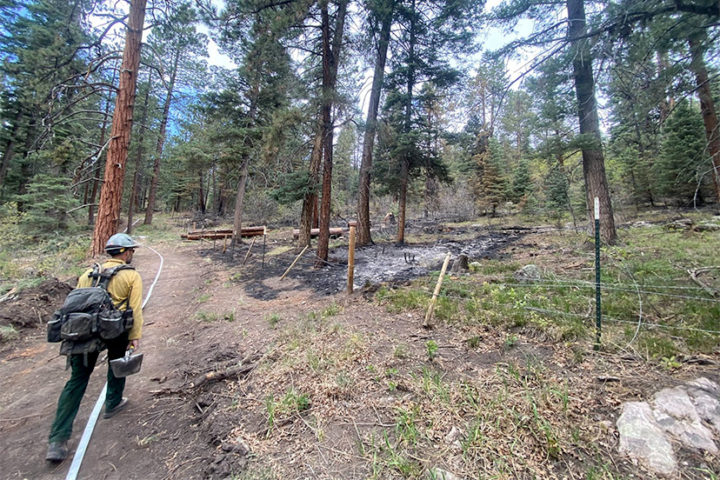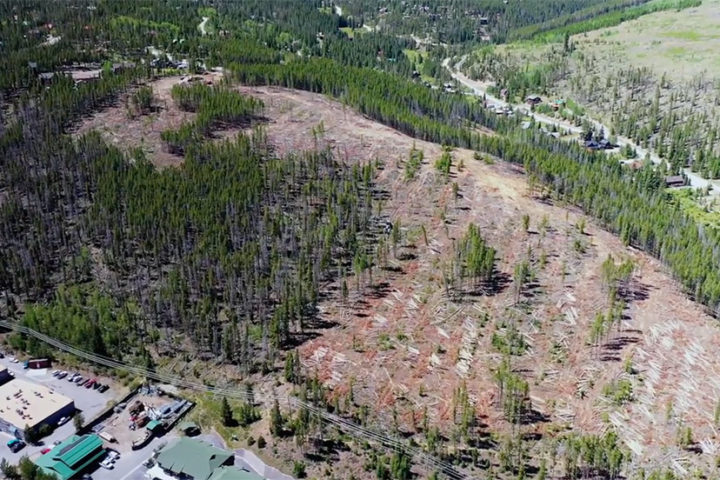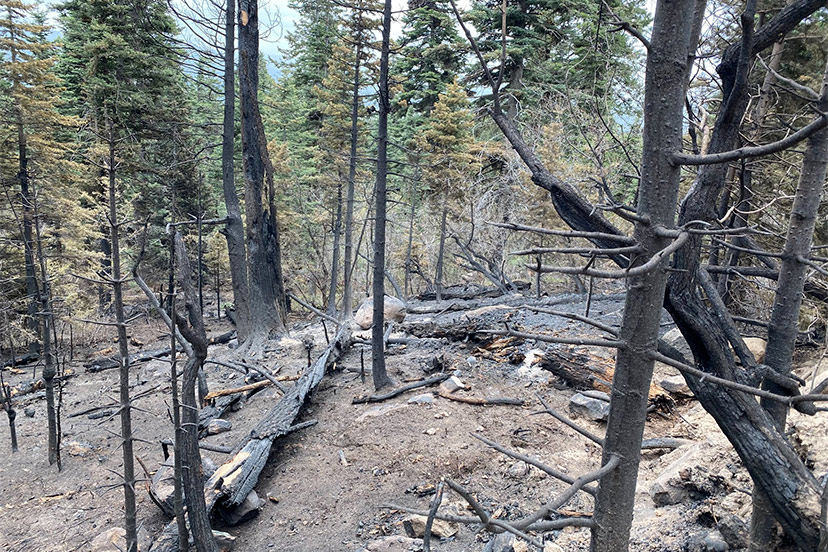Read previous Plumtaw Fire stories, beginning on May 18, here.
The official report on the Plumtaw Fire for Tuesday, May 24, showed no growth of the fire’s footprint, and containment at 51% — up from 33% yesterday, and 12% on Sunday. And 0% on Saturday. If this trend continues, the fire will be totally contained within the next few days.
A ‘chipper’ has been added to the consigned equipment. “Slash will be chipped to eliminate fuel at the controlled edge of the fie perimeter…”
Fire resources continue to make progress securing the fire perimeter, taking advantage of the cool, cloudy weather and lower temperatures. Excess resources will be released when they are no longer needed to meet Plumtaw fire objectives, due to the considerable of amount of work completed since the fire started. With extensive hose lay and water supply in place, minimal helicopter support is required by crews that are isolating and extinguishing hot spots, and two helicopters have been released. Needed firefighters, aviation resources, and equipment will remain on the uncontrolled fire line until containment objectives are met. Engines, sprinkler kits and hose will remain in the Lost Valley of the San Juans subdivision.
The photo below shows a section of the 6,000 feet of hose that has been run through the affected area. The plan for yesterday was to remove the hoses from areas where no hot spots remain.

As has been mentioned already in this article series, the area where the Plumtaw Fire burned 721 acres had been identified, several years ago, by the San Juan Headwaters Forest Health Partnership, as an ideal place to perform large-scale wildfire mitigation within the San Juan National Forest. That decision was based at least partly on the fact that Pagosa Springs draws much of its drinking water from the Fourmile watershed. A wildfire in this area had the potential not only to damage Pagosa Area Water and Sanitation District (PAWSD) infrastructure, but also could result in polluting soil erosion following a fire event.
Another typical concern, when forestry experts are choosing locations for wildfire mitigation that will involve mechanical thinning of trees, is the topography. Conventional logging machinery performs poorly (and less economically) on steeply sloping sites. Like, say, in the Rocky Mountains. As catastrophic wildfire becomes an increasingly important concern in the American West — and elsewhere — new types of machinery are being developed to handle tree thinning on steep slopes.
Here’s a 4-minute video posted by Denver Water. From the YouTube description:
Summit County, Colorado is taking preventative steps to protect homes from wildfires. This video shows how a unique machine called a Ponsse harvester is helping thin the forest in the Peak 7 neighborhood. You can also learn how this effort protects the water that flows into Dillon Reservoir for Denver Water customers.
The video makes it clear that this collaborative project is addressing a couple of problems. Denver Water is helping fund the project, to protect one of its water sources: Lake Dillon. Summit County is hoping to protect a subdivision developer who was (foolishly?) allowed to create a neighborhood of over 450 homes in the midst of an ‘unhealthy’ forest.
Near the end of this video, we hear from Colorado State Forest Service forester Ryan McNertney.
“These forests are designed to burn. They’re built to burn. They’ve burned before and they’re gonna burn again. It’s just a matter of where it happens, and when it happens… not ‘if’ it happens. So we need to be as best prepared as we can, when that does happen…”
We then get an aerial view of the project.
Not a pretty sight, in my opinion.

But maybe a necessary sight?
The video notes that this particular effort was funded by a couple of groups. The Summit County taxpayers, and the Denver Water customers.
One thing the video doesn’t explain is, what happens to all the cut trees generated by the project? Will they be sawn into lumber, for example? And maybe used to build homes in a county that is suffering from a housing crisis similar to the one going on in Archuleta County?
As we watch new homes go up here in Pagosa, the kiln-dried dimensional lumber for those homes is typically coming from Canada.
The creation of a local industry to produce valuable lumber, in a place like Archuleta County, faces a number of challenges, however. The most obvious challenge might be: where to locate a lumber mill large enough to handle all the logs produced by an aggressive forest thinning program, and how to finance such a large mill. Or alternatively, several smaller mills that cooperatively share certain resources?
But other challenges also exist. The American construction industry traditionally uses ‘graded’ kiln-dried lumber. Because no two trees are exactly alike, sawn lumber varies in overall appearance and structural properties. In the United States, lumber is graded to establish a degree of reliability in the value of a mill’s final products.
Currently, the small saw mills that operate in Pagosa and Durango produce ungraded green lumber — a type of lumber not typically used in modern home construction. Our community could feasibly begin producing graded lumber, but that would require the existence of one or more industrial-size kilns to dry the sawn lumber. According to the discussion I heard last week at the Forest Health Partnership meeting, lumber cannot be graded unless it’s first kiln-dried.
Then, we would need a specialist trained in the art of grading lumber. We don’t currently have any such expert in our community.
But if we did… and if we were committed to thinning our ‘unhealthy’ forests… we might be able to supply our local construction industry with the framing materials they need… and avoid trucking in Canadian lumber from 2,000 miles away.
Save money on diesel fuel, perhaps? Diesel fuel has gotten pretty darned expensive lately.
Read May 26 update…

